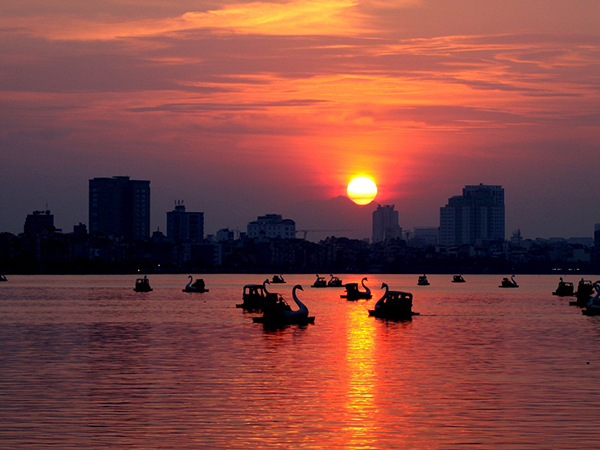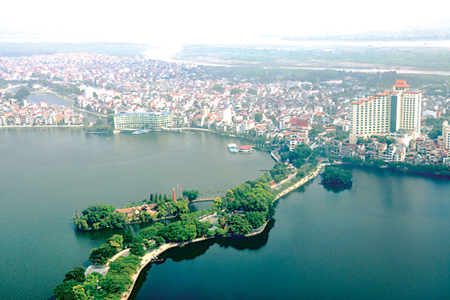Whenever Liz got the blues I would tell her: "Listen straddle your bike, we'll pop over to the West Lake."
The visit was always a success: there were so many things to see, so many pages of history to evoke.
In summer, surrounded by the exhilarating music of the cicadas and the bright red of the flowers of the flame-trees, we would enjoy the cool air sitting on the grass of the Co Ngu causeway and looking at the fireworks of the sunset. In winter, with the mist blurring the shapes of the trees and the fishermen’s boats, we might think we were admiring a landscape in a wash drawing. The Lake then truly deserved its old name of Lake of the Mists (Dam Dam) by which it was called in the 11th century.
According to one legend the place was originally thickly wooded and inhabited by a fox demon with nine tails. The monster was later killed by the Dragon King, the ancestor of the Viet people, who drowned it under floods of water, thereby creating a lake. Another legend tells us that the Vietnamese monk Khong To (11th century), who rendered great services to the emperor of China, was allowed to take back to the country large amounts of bronze which he used to cast an enormous bell. When the bell was rung its sound was so powerful and carried so far that the Golden Calf, thinking it was its buffalo-mother's voice calling, hurriedly rushed south to her, and in its frantic search for her turned up mounds of earth and brought into existence an enormous hollow which filled with water and became a lake When I was a small child I found the story quite credible together with the legend that went with it that any family with ten nude children could try to entice the Golden Calf to emerge from the lake.
We offer wonderful excursions in Vietnam or some places such as: Excursions in Hanoi or Excursion in Ho Chi Minh City

In the middle ages many palaces and pavilions were built by the Ly, Tran and Le kings and the Trinh seigneurs. They stood on the banks of the West Lake and also at the edge of Lake Truc Bach, separated from it by the Co Ngu causeway, and now renamed the Youth promenade. Truc Bach means white silk woven at the Ivory Bamboo village. A pavilion was built there by a Trinh seigneur, where he relegated his neglected concubines. The poor women devoted their time to silk weaving. The product of their looms was a very beautiful kind of white silk.
In 1802 a scholar named Nguyen Huy Luong wrote a piece of rimed prose (phu) which became famous. It was entitled: Hymn to the West Lake. It sang the beauty of the landscape and glorified the achievements of the Tay Son dynasty which had driven out the Ching invaders and brought peace to the country. Later, however, another scholar named Pham Thai who stood for the restoration of the Le dynasty wrote a political pamphlet in literary form which became no less famous. In this writing entitled "Against the Hymn to the West Lake" he used the same rimes as appeared in Nguyen Huy Luong’s work to say just the opposite.
The 17-km road encircling the Lake provides cyclists with the pleasure of ever-renewed discoveries: first the Flower Villages which at the approach of Tet, the lunar New Year, supply the cityfolk with an unending stream of peach blossoms and dwarf tangerine trees as well as flowers of all kinds: Nhat Tan, Ngoc Ha, Nghi Tam (the last-named now specializing in the growing of bonsai and the breeding of goldfish); next, Quang Ba with its guava trees, Tay Ho with its "Palace of the Saintly Matrons" (phu), Xuan Tao with the temple dedicated to the child-hero of Giong, Trich Sai with the Thien Nien pagoda where is honoured the patron saint of the weavers of black satin, Ke Buoi famous for its hand-made paper, Thuy Khe with the pagoda dedicated to Dame Danh... Of course one should not forget the Taoist temple Quan Thanh (called by the French Pagoda du Grand Bouddha because of the existence there of a giant bronze statue of the guardian god of the North, Huyen Thien Tran Vu) and the Tran Quoc pagoda standing on a small peninsula jutting out into the lake and believed to have had its first buildings constructed as far back as the 6th century.
For all the pleasure of the trip, though, there is a fly in the ointment now: the eye sores represented by arrogant villas of the nouveaux riches, most of them dubious taste.



